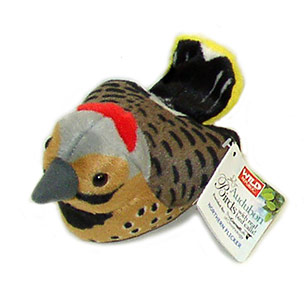

Find out all about the Northern Flicker in the Aviary at the Forest Cottage.
The Northern Flicker is a large (10 to 11-inch) woodpecker that includes five subspecies: yellow-shafted flicker, red-shafted flicker, gilded flicker, Guatemalen flicker and Cuban flicker. The birds are generally brownish grey in color with black barring on the back, wings and tail. The breast is lighter with black spots. There is a black collar on the breast. Field notes include a white rump, yellow or salmon under the wings and tail in flight. Subspecies also differ in the color of the throat, crown and some have a red blaze on the back of the head. The males have a mustache, also called a malar stripe, that is black in some subspecies and red in others.
Flickers are monogamous and mate for life. Breeding begins in late April and early May. They are cavity nesters. They prefer digging into dead or decaying trees where they can find weak wood to excavate. They will also excavate poles and fence posts and sometimes use nest boxes. Older adults will return to the same breeding site year after year.
It can take up to two weeks to prepare the cavity. The female lays one egg each day until she has from five to eight eggs. The eggs are white. Both parents tend the nest. Incubation is from 11 to 14 days from the day the last egg is laid The young fledge in about a month. There is generally one brood raised per year but in the southern range there can be two.
Flickers feed on many things including ants, beetles, wasps, caterpillars, acorns, nuts, grains, berries and fruits. They will, on occasion, visit feeders.
Northern Flickers can be found thoughout North America, Mexico, Central America and Cuba. They frequent urban, suburban and rural areas.
Class: Aves | Order: Piciformes | Family: Picidae | Genus: Colaaptes | Species: C. auratus





